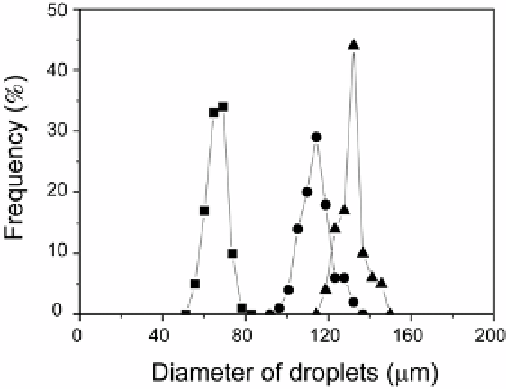Biomedical Engineering Reference
In-Depth Information
uses air as an ambient fluid (Figure 1a). The inner needle is positioned upstream in the
vicinity of a coaxial outer tubule in which the water-immiscible liquid (liquid paraffin is used
in our study) is flowed. Formation of the droplets smaller than the needle diameter is achieved
at the tip of a stretched aqueous solution ligament much thinner than the needle diameter, that
is, via jetting (Figure 3) [28]. When a disperse phase is injected from a capillary into an
immiscible liquid flow at laminar flow, two different droplet breakup modes are observed.
Specifically, droplets either form close to the capillary tip, called dripping, or break up at the
tip of a stretched liquid jet, called jetting [29]. The formation of a jet thinner than the needle
diameter is interpreted as a consequence of being stretched by the drag force exerted by the
ambient co-flowing fluid. In general, the behavior of the extruded solution into the co-flowing
fluid is affected by a complicated balance of three forces [30-32]: the interfacial tension force,
Figure 2. Size distribution of 2.0 wt% sodium-alginate extruded from a needle with 480 μm i.d., 700
μm o.d. at (■) 1.2 cm/sec, (●) 2.6 cm/sec, and (▲) 4.7 cm/sec into a co-flowing liquid paraffin stream
with a flow rate of 17.5 cm/sec (Reproduced with permission, from Sakai S et al. Biotechol. Bioeng.
[28] @ 2004 Wiley Periodicals, Inc.).
Figure 3. Sodium-alginate aqueous solution (194 mPa⋅s) extruded from a needle of 300 μm i.d. and 480
μm o.d. into the ambient liquid paraffin stream. The velocities of the sodium-alginate aqueous solution
and liquid paraffin were 1.2 cm/sec and 23.5 cm/sec, respectively (Reproduced with permission, from
Sakai S et al. Biotechol. Bioeng. [28] @ 2004 Wiley Periodicals, Inc.).



